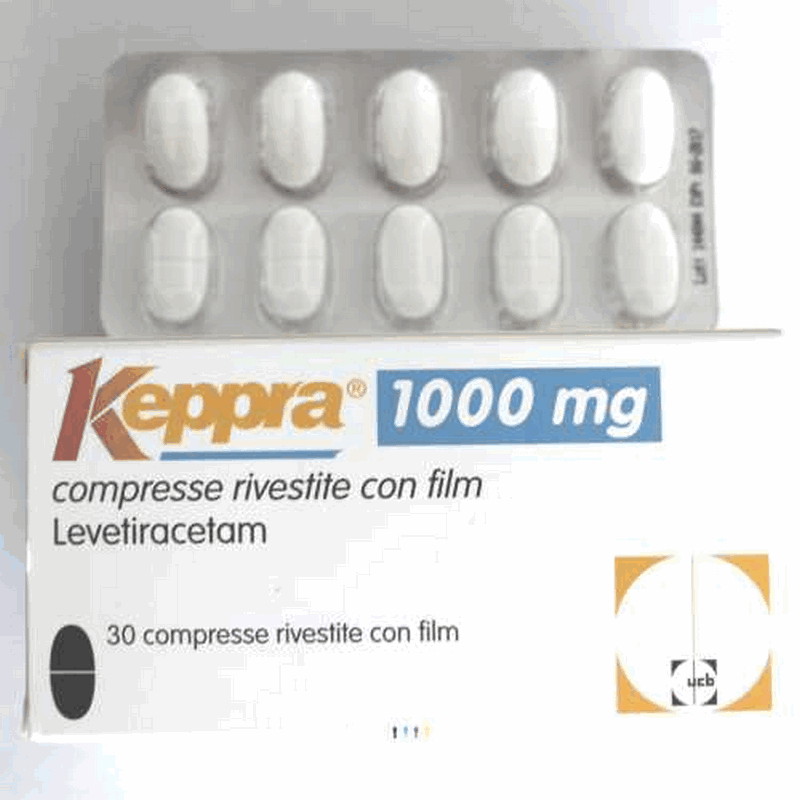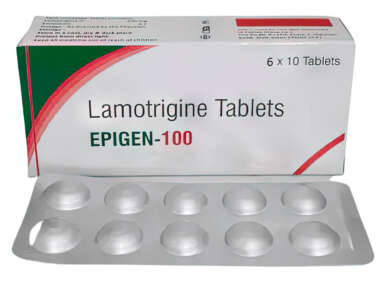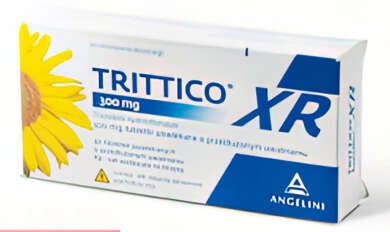Description
Buy Keppra Levetiracetamum tablets 1000 mg tablets #30
Description of Keppra:
Levetiracetam is a derivative of pyrrolidone (S-enantiomer of alpha-ethyl-2-oxo-1-pyrrolidine-acetamide), whose chemical structure differs from known antiepileptic drugs.
In vitro studies have shown that levetiracetam affects intraneuronal Ca2+ levels by partially inhibiting the current through N-type Ca2+ channels and reducing the release of Ca2+ from intraneuronal stores. It also partially reverses the inhibition of GABA- and glycine-regulated current caused by the action of zinc and β-carbolines. The binding site is synaptic vesicle protein 2A, which is involved in vesicle fusion and neurotransmitter release.
Levetiracetam provides anticonvulsant protection in a wide range of partial and primary generalized seizure models without providing anticonvulsant effects.
The activity of the drug has been confirmed both in relation to focal and generalized epileptic seizures (epileptiform manifestations/photoparoxysmal reaction).
Ingredients:
Active substance: 1 tablet contains levetiracetam 1000 mg;
Excipients: croscarmellose sodium, macrogol 6000, colloidal anhydrous silicon dioxide, magnesium stearate.
Film coating: opadry 85F18422: polyvinyl alcohol, titanium dioxide (E 171), macrogol 3350, talc.
Pharmacodynamics of Keppra 1000 mg tablets # 30:
Levetiracetam provides anti-seizure protection in a wide range of animal models of partial and primary generalized seizures without causing a seizure effect. The main metabolite is inactive.
In humans, the activity of the drug has been confirmed by both partial and generalized epileptic seizures (epileptiform manifestations/photoparoxysmal reaction), which indicates a wide range of pharmacological profile of levetiracetam.
Pharmacokinetics of Keppra 1000 mg tablets # 30:
Levetiracetam is characterized by high solubility and permeability. Pharmacokinetics are linear and characterized by low inter- and intrasubject variability. After repeated use of the drug, clearance does not change. There was no evidence of an effect of gender, race, or circadian rhythm on pharmacokinetics. The pharmacokinetic profile was similar in healthy volunteers and patients with epilepsy.
Due to complete and linear absorption, drug plasma levels can be inferred from the oral dose of levetiracetam expressed in mg/kg body weight. Therefore, it is not necessary to monitor plasma levels of levetiracetam.
In adults and children, there was a significant correlation between salivary and plasma drug concentrations (saliva/plasma concentration ratios ranged from 1 to 1.7 after oral tablet administration and 4 hours after oral solution administration).
Adults and teenagers.
Suction.
Levetiracetam is rapidly absorbed after oral administration. Absolute oral bioavailability is about 100%. Peak plasma concentration (Cmax) is reached 1.3 hours after taking the drug. An equilibrium state is achieved after 2 days of using the drug twice a day. Peak concentrations (Cmax) are typically 31 and 43 mcg/mL after a single dose of 1000 mg and a repeat dose of 1000 mg twice daily, respectively. The degree of absorption does not depend on the dose and does not change with food.
Distribution
There are no data on the distribution of the drug in human tissues. Neither levetiracetam nor its main metabolite is significantly bound to plasma proteins (<10%). The volume of distribution of levetiracetam is approximately 0.5 to 0.7 L/kg, which is approximately equal to total body water.
Metabolism.
The metabolism of levetiracetam in humans is negligible. The main route of metabolism (24% of the dose) is enzymatic hydrolysis of the acetamide group. Hepatic cytochrome P450 isoforms are not involved in the formation of the main metabolite, ucb L057. Hydrolysis of the acetamide group has been observed in a large number of tissues, including blood cells. Metabolite ucb L057 is pharmacologically inactive.
Two minor metabolites were also identified. One was formed as a result of hydroxylation of the pyrrolidone ring (1.6% of the dose), the second – due to the opening of the pyrrolidone ring (0.9% of the dose).
Other unidentified components accounted for only 0.6% of the dose.
No interconversion of the enantiomers of levetiracetam or its main metabolite was observed under in vivo conditions.
In in vitro studies, levetiracetam and its main metabolite did not inhibit the activity of the major human hepatic cytochrome P450 isoforms (CYP3A4, 2A6, 2C9, 2C19, 2D6, 2E1 and 1A2), lucuronyl transferase (UGT1A1 and UGT1A6) and epoxide hydroxylase. Levetiracetam also does not inhibit the glucuronidation of valproic acid in vitro.
In cultured human hepatocytes, levetiracetam had little or no effect on CYP1A1/2, SULT1E1, or UGT1A1. Levetiracetam caused a weak induction of CYP2B6 and CYP3A4. In vitro data and in vivo data on interactions with oral contraceptives, digoxin and warfarin indicate that significant enzyme induction is not expected under in vivo conditions. Therefore, interaction of Keppra with other substances or vice versa is unlikely.
Removal
The half-life of the drug from blood plasma in adults was 7±1 hours and did not depend on the dose, route of administration or repeated use. The average total clearance was 0.96 ml/min/kg.
The main amount of the drug, on average, 95% of the dose was excreted in the urine (approximately 93% of the dose was excreted within 48 hours). Only 0.3% of the dose is excreted in feces.
The cumulative urinary excretion of levetiracetam and its main metabolite was 66% and 24% of the dose, respectively, in the first 48 hours. The renal clearance of levetiracetam and ucb L057 is 0.6 and 4.2 ml/min/kg, respectively, indicating that levetiracetam is eliminated by glomerular filtration followed by tubular reabsorption and that the major metabolite is also eliminated by active tubular secretion in addition to glomerular filtration. Elimination of levetiracetam correlates with creatinine clearance.
Elderly patients.
In elderly patients, the half-life increases by approximately 40% (10-11 hours). This is associated with worsening kidney function in this population
Renal dysfunction.
The apparent total clearance of levetiracetam and its major metabolite correlates with creatinine clearance. Therefore, in patients with moderate to severe renal impairment, it is recommended that the maintenance daily dose of Keppra be adjusted according to creatinine clearance.
In anuric patients with end-stage renal disease, the half-life was approximately 25 and 3.1 hours, respectively, between and during dialysis. During a typical 4-hour dialysis session, 51% of levetiracetam was eliminated.
Liver dysfunction.
The clearance of levetiracetam did not change in patients with mild to moderate hepatic impairment. In most patients with severe hepatic impairment, the clearance of levetiracetam was reduced by more than 50% due to concomitant renal impairment (see section “Dosage and Administration”).
Pediatric population.
Children 4-12 years old.
After a single dose (20 mg/kg) was administered to children with epilepsy (6 to 12 years), the half-life of levetiracetam was 6 hours. The apparent clearance, adjusted for body weight, was approximately 30% higher than in adult patients with epilepsy. After repeated oral administration (20-60 mg/kg/day) in children with epilepsy (4-12 years), levetiracetam was rapidly absorbed. Peak plasma concentrations were achieved 0.5-1 hour after dosing. Peak concentrations and area under the concentration-time curve increased linearly and were dose-dependent. The half-life was approximately 5 hours; apparent total clearance is 1.1 ml/min/kg.
Indications for use of Keppra 1000 mg tablets # 30:
Monotherapy (drug of first choice) in the treatment of:
partial seizures with or without secondary generalization in adults and adolescents over 16 years of age who are newly diagnosed with epilepsy.
As an additional therapy in the treatment of:
partial seizures with or without secondary generalization in adults, adolescents and children over 6 years of age with epilepsy;
myoclonic seizures in adults and adolescents over 12 years of age with juvenile myoclonic epilepsy;
primary generalized convulsive (tonic-clonic) seizures in adults and adolescents over 12 years of age with idiopathic generalized epilepsy.
Contraindications of Keppra 1000 mg tablets # 30:
Hypersensitivity to levetiracetam or other pyrrolidone derivatives, as well as to any excipients of the drug.
Interactions:
Antiepileptic drugs.
Pre-marketing data from clinical studies in adults indicate that levetiracetam does not affect the serum concentrations of existing antiepileptic drugs (phenytoin, carbamazepine, valproic acid, phenobarbital, lamotrigine, gabapentin and primidone), which do not affect the pharmacokinetics of levetiracetam.
There is no data on clinically significant drug interactions in pediatric patients or in adults receiving up to 60 mg/kg/day of levetiracetam.
A retrospective evaluation of the pharmacokinetic interaction in children and adolescents with epilepsy (aged 4 to 17 years) confirmed that adjunctive therapy with oral levetiracetam did not affect the steady-state serum concentrations of concomitantly administered carbamazepine and valproate. However, data suggest that the clearance of levetiracetam is 20% higher in children taking enzyme-inducing antiepileptic drugs. No dose adjustment is required.
Probenecid.
Probenecid (500 mg 4 times daily), a drug that blocks renal tubular secretion, inhibits the renal clearance of the main metabolite, but not levetiracetam itself. However, concentrations of this metabolite remain low.
Methotrexate.
Concomitant use of levetiracetam and methotrexate has been reported to reduce the clearance of methotrexate, resulting in increased/prolonged methotrexate blood concentrations to potentially toxic levels. Blood levels of methotrexate and levetiracetam should be carefully monitored in patients receiving treatment with both drugs simultaneously.
Oral contraceptives and pharmacokinetic interactions with other drugs.
Levetiracetam at a daily dose of 1000 mg does not change the pharmacokinetics of oral contraceptives (ethinylestradiol and levonorgestrel); endocrine parameters (levels of luteinizing hormone and progesterone) did not change. Levetiracetam at a daily dose of 2000 mg does not change the pharmacokinetics of digoxin and warfarin; prothrombin time values remained unchanged. Digoxin, oral contraceptives and warfarin do not affect the pharmacokinetics of levetiracetam when used simultaneously.
Laxatives.
In isolated cases, decreased efficacy of levetiracetam has been reported when the osmotic laxative macrogol was coadministered with oral levetiracetam. Therefore, macrogol should not be taken orally within one hour before and within one hour after taking levetiracetam.
Food and alcohol.
The extent of absorption of levetiracetam is independent of food intake, but the rate of absorption is slightly reduced when eating. There is no data on the interaction of levetiracetam with alcohol.
Application Features
Kidney failure.
Patients with renal impairment may require levetiracetam dosage adjustment. In patients with severely impaired hepatic function, it is recommended that renal function be assessed before determining the dose of the drug (see section “Dosage and Administration”).
Acute kidney damage.
The use of levetiracetam has very rarely been accompanied by acute kidney injury, the time to onset of which ranged from several days to several months.
General blood analysis.
Rare cases of decreased blood cell counts (neutropenia, agranulocytosis, leukopenia, thrombocytopenia and pancytopenia) have been described in association with the use of levetiracetam, usually at the beginning of treatment. It is recommended that a complete blood count be performed in patients who have significant weakness, fever, recurrent infections, or bleeding disorders (section “Adverse Reactions”).
Suicide.
Cases of suicide, suicide attempts, and suicidal thoughts and behavior have been reported in patients treated with antiepileptic drugs (including levetiracetam). A meta-analysis of randomized placebo-controlled trials of antiepileptic drugs showed a slight increase in the risk of suicidal ideation and behavior. The mechanism by which this risk arises has not been studied. Due to this risk, patients should be monitored for signs of depression and/or suicidal thoughts and behavior and treatment adjusted if necessary. Patients (and their caregivers) should be advised to report any symptoms of depression and/or suicidal thoughts or behavior to their health care provider.
Unusual or aggressive behavior.
Levetiracetam may cause psychotic symptoms and behavioral disturbances, including irritability and aggressiveness. Patients taking levetiracetam should be monitored for the development of psychiatric signs indicating important changes in mood and/or personality. If such behavior occurs, it is recommended to adapt treatment or gradually withdraw it. If it is necessary to cancel treatment, see the information in the “Dosage and Administration” section.
Exacerbation of attacks.
As with other antiepileptic drugs, levetiracetam may rarely increase the frequency or severity of seizures. This paradoxical effect was more often reported during the first month after starting levetiracetam or when the dose was increased. This effect was reversible when the drug was stopped or the dose was reduced. Patients should be advised to immediately seek medical advice if their epilepsy worsens.
Prolongation of the QT interval on the electrocardiogram (ECG).
Rare cases of QT prolongation on ECG have been reported during post-marketing surveillance. Levetiracetam should be used with caution in patients with QT prolongation, patients taking concomitant medications that affect the QT interval, and patients with underlying cardiac disease or electrolyte imbalances.
Children.
The drug in tablet form is not suitable for use in infants and children under 6 years of age.
Available data in children do not indicate an effect on development and puberty. However, long-term effects on learning, intelligence, development, endocrine function, puberty, and reproduction in children remain unknown.
Use during pregnancy or breastfeeding.
Women of reproductive age.
Special recommendations should be provided to women of reproductive age. Treatment with levetiracetam should be reconsidered if a woman is planning pregnancy. As with all antiepileptic drugs, sudden withdrawal of levetiracetam should be avoided as this may lead to an attack of seizures, which can have serious consequences for the woman and the unborn child. Monotherapy should be preferred whenever possible, as treatment with multiple antiepileptic drugs may be associated with a higher risk of birth defects than monotherapy depending on the drug combination.
Pregnancy.
A large number of post-marketing data obtained from pregnant women using levetiracetam (more than 1800 women, of which 1500 women used the drug during the 1st trimester) do not indicate an increased risk of significant birth defects. There is only limited data on the neurodevelopment of children exposed to Keppra monotherapy in utero. However, existing epidemiological studies (about 100 children) do not indicate an increased risk of disorders or delays in neurodevelopment. Levetiracetam may be used during pregnancy if, after careful evaluation, it is considered clinically necessary. In this case, it is recommended to use a low effective dose.
Physiological changes during pregnancy
Overdose of Keppra 1000 mg tablets # 30:
In case of an overdose of Keppra, drowsiness, agitation, aggression, respiratory depression, depression of consciousness, and coma were observed.
Side effects:
The most commonly reported adverse reactions were nasopharyngitis, drowsiness, headaches, fatigue and dizziness. The estimated adverse event profile is based on a pooled analysis of data from placebo-controlled clinical trials for all indications, which included a total of 3416 patients treated with levetiracetam. These data are complemented by the use of levetiracetam in extended open-label studies, as well as post-marketing experience. The safety profile of levetiracetam is generally similar in different age groups (adults and children) when used for various established indications.
Storage:
Store below 25°C in original packaging. Keep out of the reach of children.
Shelf life:
3 years.





Reviews
There are no reviews yet.